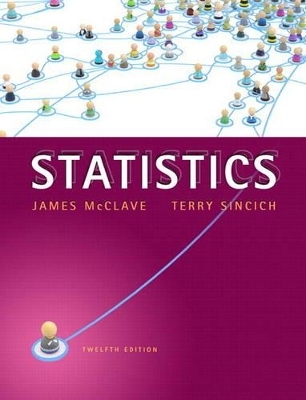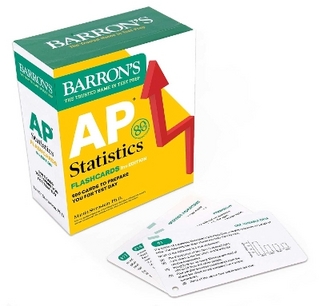
Statistics Plus NEW MyStatLab with Pearson eText -- Access Card Package
Pearson
978-0-321-89191-4 (ISBN)
- Titel ist leider vergriffen;
keine Neuauflage - Artikel merken
Packages
Access codes for Pearson's MyLab & Mastering products may not be included when purchasing or renting from companies other than Pearson; check with the seller before completing your purchase.
Used or rental books
If you rent or purchase a used book with an access code, the access code may have been redeemed previously and you may have to purchase a new access code.
Access codes
Access codes that are purchased from sellers other than Pearson carry a higher risk of being either the wrong ISBN or a previously redeemed code. Check with the seller prior to purchase.
--
Classic, yet contemporary. Theoretical, yet applied. McClave & Sincich’s Statistics gives you the best of both worlds. This text offers a trusted, comprehensive introduction to statistics that emphasizes inference and integrates real data throughout. The authors stress the development of statistical thinking, the assessment of credibility, and value of the inferences made from data.
The Twelfth Edition infuses a new focus on ethics, which is critically important when working with statistical data. Chapter Summaries have a new, study-oriented design, helping students stay focused when preparing for exams. Data, exercises, technology support, and Statistics in Action cases are updated throughout the book.
0321837746 / 9780321837745 Statistics plus MyStatLab Student Access Kit
Package consists of:
0321694635 / 9780321694638 MyStatLab -- Access Card
0321755936 / 9780321755933 Statistics
Dr. Jim McClave is currently President and CEO of Info Tech, Inc., a statistical consulting and software development firm with an international clientele. He is also currently an Adjunct Professor of Statistics at the University of Florida, where he was a full-time member of the faculty for twenty years. Dr. Terry Sincich obtained his PhD in Statistics from the University of Florida in 1980. He is an Associate Professor in the Information Systems & Decision Sciences Department at the University of South Florida in Tampa. Dr. Sincich is responsible for teaching basic statistics to all undergraduates, as well as advanced statistics to all doctoral candidates, in the College of Business Administration. He has published articles in such journals as the Journal of the American Statistical Association, International Journal of Forecasting, Academy of Management Journal, and the Auditing: A Journal of Practice & Theory. Dr. Sincich is a co-author of the texts Statistics, Statistics for Business & Economics, Statistics for Engineering & the Sciences, and A Second Course in Statistics: Regression Analysis.
1. Statistics, Data, and Statistical Thinking
1.1 The Science of Statistics
1.2 Types of Statistical Applications
1.3 Fundamental Elements of Statistics
1.4 Types of Data
1.5 Collecting Data
1.6 The Role of Statistics in Critical Thinking
Statistics in Action: Social Media Networks and the Millennial Generation
Using Technology: Creating and Listing Data
2. Methods for Describing Sets of Data
2.1 Describing Qualitative Data
2.2 Graphical Methods for Describing Quantitative Data
2.3 Summation Notation
2.4 Numerical Measures of Central Tendency
2.5 Numerical Measures of Variability
2.6 Interpreting the Standard Deviation
2.7 Numerical Measures of Relative Standing
2.8 Methods for Detecting Outliers: Box Plots and z-Scores
2.9 Graphing Bivariate Relationships (Optional)
2.10 Distorting the Truth with Descriptive Techniques
Statistics In Action: Body Image Dissatisfaction: Real or Imagined?
Using Technology: Describing Data
3. Probability
3.1 Events, Sample Spaces, and Probability
3.2 Unions and Intersections
3.3 Complementary Events
3.4 The Additive Rule and Mutually Exclusive Events
3.5 Conditional Probability
3.6 The Multiplicative Rule and Independent Events
3.7 Random Sampling
3.8 Some Additional Counting Rules (Optional)
3.9 Bayes’ Rule (Optional)
Statistics In Action: Lotto Buster! –Can You Improve Your Chances of Winning the Lottery?
Using Technology: Generating a Random Sample
4. Discrete Random Variables
4.1 Two Types of Random Variables
4.2 Probability Distributions for Discrete Random Variables
4.3 Expected Values of Discrete Random Variables
4.4 The Binomial Random Variable
4.5 The Poisson Random Variable (Optional)
4.6 The Hypergeometric Random Variable (Optional)
Statistics in Action: Probability in a Reverse Cocaine Sting– Was Cocaine Really Sold?
Using Technology: Discrete Probabilities
5. Continuous Random Variables
5.1 Continuous Probability Distributions
5.2 The Uniform Distribution
5.3 The Normal Distribution
5.4 Descriptive Methods for Assessing Normality
5.5 Approximating a Binomial Distribution with a Normal Distribution (Optional)
5.6 The Exponential Distribution (Optional)
Statistics in Action: Super Weapons Development — Is the Hit Ratio Optimized?
Using Technology: Continuous Random Variables, Probabilities, and Normal Probability Plots
6. Sampling Distributions
6.1 What is a Sampling Distribution?
6.2 Properties of Sampling Distributions: Unbiasedness and Minimum Variance
6.3 The Sampling Distribution of (x-bar) and the Central Limit Theorem
Statistics in Action: The Insomnia Pill–Will It Take Less Time to Fall Asleep?
Using Technology: Simulating a Sampling Distribution
7. Inferences Based on a Single Sample: Estimation with Confidence Intervals
7.1 Identifying and Estimating the Target Parameter
7.2 Confidence Interval for a Population Mean: Normal (z) Statistic
7.3 Confidence Interval for a Population Mean: Student's t-statistic
7.4 Large-Sample Confidence Interval for a Population Proportion
7.5 Determining the Sample Size
7.6 Confidence Interval for a Population Variance (Optional)
Statistics in Action: Medicare Fraud Investigations
Using Technology: Confidence Intervals
8. Inferences Based on a Single Sample: Tests of Hypothesis
8.1 The Elements of a Test of Hypothesis
8.2 Formulating Hypotheses and Setting Up the Rejection Region
8.3 Test of Hypothesis About a Population Mean: Normal (z) Statistic
8.4 Observed Significance Levels: p-Values
8.5 Test of Hypothesis About a Population Mean: Student's t-statistic
8.6 Large-Sample Test of Hypothesis About a Population Proportion
8.7 Calculating Type II Error Probabilities: More About β (Optional)
8.8 Test of Hypothesis About a Population Variance (Optional)
Statistics in Action: Diary of a Kleenex User–How Many Tissues in a Box?
Using Technology: Tests of Hypothesis
9. Inferences Based on a Two Samples: Confidence Intervals and Tests of Hypotheses
9.1 Identifying the Target Parameter
9.2 Comparing Two Population Means: Independent Sampling
9.3 Comparing Two Population Means: Paired Difference Experiments
9.4 Comparing Two Population Proportions: Independent Sampling
9.5 Determining the Sample Size
9.6 Comparing Two Population Variances: Independent Sampling (Optional)
Statistics in Action: Zixit Corp. vs. Visa USA Inc.–A Libel Case
Using Technology: Two-Sample Inferences
10. Analysis of Variance: Comparing More Than Two Means
10.1 Elements of a Designed Study
10.2 The Completely Randomized Design: Single Factor
10.3 Multiple Comparisons of Means
10.4 The Randomized Block Design
10.5 Factorial Experiments: Two Factors
Statistics in Action: On the Trail of the Cockroach: Do Roaches Travel at Random?
Using Technology: Analysis of Variance
11. Simple Linear Regression
11.1 Probabilistic Models
11.2 Fitting the Model: The Least Squares Approach
11.3 Model Assumptions
11.4 Assessing the Utility of the Model: Making Inferences About the Slope β1
11.5 The Coefficients of Correlation and Determination
11.6 Using the Model for Estimation and Prediction
11.7 A Complete Example
Statistics in Action: Can "Dowsers" Really Detect Water?
Using Technology: Simple Linear Regression
12. Multiple Regression and Model Building
12.1 Multiple Regression Models
12.2 The First-Order Model: Inferences About the Individual β-Parameters
12.3 Evaluating the Overall Utility of a Model
12.4 Using the Model for Estimation and Prediction
12.5 Model Building: Interaction Models
12.6 Model Building: Quadratic and other Higher-Order Models
12.7 Model Building: Qualitative (Dummy) Variable Models
12.8 Model Building: Models with both Quantitative and Qualitative Variables
12.9 Model Building: Comparing Nested Models (Optional)
12.10 Model Building: Stepwise Regression (Optional)
12.11 Residual Analysis: Checking the Regression Assumptions
12.12 Some Pitfalls: Estimability, Multicollinearity, and Extrapolation
Statistics in Action: Modeling Condo Sales: Are There Differences in Auction Prices?
Using Technology: Multiple Regression
13. Categorical Data Analysis
13.1 Categorical Data and the Multinomial Distribution
13.2 Testing Categorical Probabilities: One-Way Table
13.3 Testing Categorical Probabilities: Two-Way (Contingency) Table
13.4 A Word of Caution About Chi-Square Tests
Statistics in Action: College Students and Alcohol–Is Drinking Frequency Related to Amount?
Using Technology: Chi-Square Analyses
14. Nonparametric Statistics*
14.1 Introduction: Distribution-Free Tests
14.2 Single Population Inferences
14.3 Comparing Two Populations: Independent Samples
14.4 Comparing Two Populations: Paired Difference Experiment
14.5 Comparing Three or More Populations: Completely Randomized Design
14.6 Comparing Three or More Populations: Randomized Block Design
14.7 Rank Correlation
Statistics in Action: How Vulnerable are Wells to Groundwater Contamination?
Using Technology: Nonparametric Analyses
Appendix A. Tables
Table I. Random Numbers
Table II. Binomial Probabilities
Table III. Poisson Probabilities
Table IV. Normal Curve Areas
Table V. Exponentials
Table VI. Critical Values of t
Table VII. Critical Values of x2
Table VIII. Percentage Points of the F Distribution, α=.10
Table IX. Percentage Points of the F Distribution, α=.05
Table X. Percentage Points of the F Distribution, α=.025
Table XI. Percentage Points of the F Distribution, α=.01
Table XII. Critical Values of TL and TU for the Wilcoxon Rank Sum Test
Table XIII. Critical Values of T0 in the Wilcoxon Signed Rank Test
Table XIV. Critical Values of Spearman's Rank Correlation Coefficient
Appendix B. Calculation Formulas for Analysis of Variance
Short Answers to Selected Odd-Numbered Exercises
*This chapter is included on the CD-ROM that comes with the textbook.
| Erscheint lt. Verlag | 28.11.2012 |
|---|---|
| Sprache | englisch |
| Maße | 224 x 279 mm |
| Gewicht | 1860 g |
| Themenwelt | Mathematik / Informatik ► Mathematik ► Statistik |
| ISBN-10 | 0-321-89191-0 / 0321891910 |
| ISBN-13 | 978-0-321-89191-4 / 9780321891914 |
| Zustand | Neuware |
| Haben Sie eine Frage zum Produkt? |
aus dem Bereich


